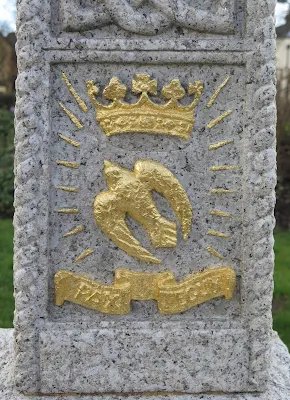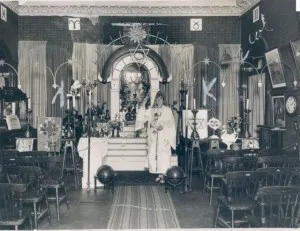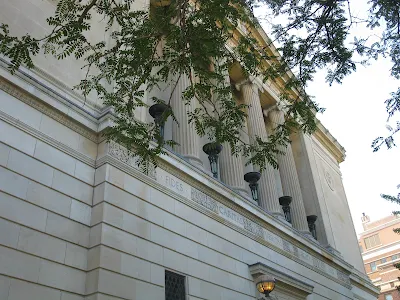-o-
Here are my edited notes of what RR Skinner recalled of his mother, Elizabeth Mary Eagle Skinner (30 Aug. 1875 - 24 Nov. 1929):
His mother was a tall and imposing woman; possibly six feet tall. She would take a push cart and collect toys in the wealthy west end of London and then distribute them in the poor east end; no wonder there was such a large turnout for her funeral, people loved her as did her family. She started a church and took on the name of The Paracleta. Reg would be present at the church meetings and from this he began to learn about people's psychology; he learned how to "read" people and how to do psychic readings. RR's mother intended him to be her successor and to be a world teacher, she held this belief about him before his birth. Part of her church service was delivering the sacraments. The spirit she communicated with, or was a medium for, or who she channelled, was a North American Indian who was called Idvill. The Paracleta prophesied the coming of World War One and prepared for food shortages by filling large metal trunks with dried fruit. During her last ten years she lived in her church where she had a bedroom. When she died her followers stripped the church of its decorations and ornaments.
. . . . .
The night RR’s mother died: RR went to his mother when he heard her laboured breathing, this was caused by asthma; Reg said, “No one dies of asthma”, but his mother died of asthma. She had asked for ice cream and RR, noticing it was by the fire, told her it had melted, it had been spoiled by the heat. He felt she was dying; later that night his sister, who was caring for their mother, called their father and RR. While the father put on his spats, moving slowly about his library, RR rushed to his mother's room. They were very close -- she had written to his future godmother, before RR was born, that he was to be the future avatar or world teacher and she trained RR on how to give psychic readings. Reaching her bedroom RR found her body in her bed, her head hanging to one side and mouth open. RR took a towel and tied it around her head closing her mouth; he remarked to me how detached he was when doing this.
RR wonders why he developed throat cancer two years after his mother's passing. It was years later that he realized, and believed, that it may have been caused by his emotional repression of his mother's death; he believed because he did not speak of her passing, or of how close he had been to her, that this repression caused his throat cancer. A well-known Scottish doctor, whose specialty was cancer, removed the cancerous growth in his neck. He had a long convalescence and was not expected to survive the surgery. Fifty years later, sitting with Reg as he discussed this time in his life, he opened the collar of his shirt and showed me the scar where the doctor had operated.
-o-
Welby Arthur Skinner (13 Nov. 1896 - 06 Dec. 1984) became the family head after their mother died. In the early years of the 20th Century he was invited to visit Czarist Russia to lecture on the new radio technology. The radio licence that the BBC holds was issued after Welby received his license. Welby was also a visual artist and a member of the Royal Academy of Artists; RR would deliver Welby's paintings to the Royal Academy's exhibitions. Finally, Welby was a dental surgeon with his office at 44 Harley Street West in London (this is still a dental office; as an aside, years ago when I was writing this narrative about RR Skinner I contacted the dentist who bought Welby's dental practise; what he said was that Welby arrived sitting in the back seat of his Rolls Royce, the Rolls will be mentioned again). When Welby went to fight in World War One, sending home watercolour post cards that he had painted, their mother temporarily took over his medical practise, performing extractions, fillings, and other dental operations. RR is missing several teeth because he allowed Welby to extract them for practise. (I have omitted RR's memories of his sister Joan and his brother Ronald). He remembered with fondness his two elderly sisters, Girlie and Doris.
... Within six months of RR's mother's passing, his father (Arthur John Skinner, 11 June 1867 - 25 March 1953) was looking for a new wife. This was something of which Welby disapproved; Welby called a family meeting and had his father put out of the family home. RR had a photograph of his father sitting in a tiny London garden located behind the house of his father's second wife, he was a tiny lonely old man; RR's father had a daughter with his second wife. When Flossie (Florence Skinner, 4 Oct. 1891 - 18 Feb. 1960), Welby's first wife, suffered a stroke in the late 1950s, RR went to visit them in London. Flossie sat in a chair by a window and Welby spoke of her condition in front of her, he said, "All she can do is shit and piss." RR was upset by Welby's crude comment; he visited Flossie afterwards and attempted to communicate with her. It was Welby's insensitivity that alienated RR from Welby. And then, after Flossie died, Welby remarried but RR never visited them and never met Welby's new wife and her son.
During the 1930s RR worked for Nestle, possibly as a manager, and he spoke of firing numerous people; the other employees hated him so much that one day a hostile group of them waited for him at the entrance to the Nestle factory, but he seems to have intimidated them and the gang dispersed.
RR said that he had two adopted brothers, Eric and Victor. He had a sister, Ruthie, who failed to return home from school one day, it was believed she was kidnapped for she was never seen again; they adopted Victor to replace Ruthie. While RR and Welby went to public schools, to Aleyn's, Dulwich, where their father taught geography, another brother, Cyril, went to a council school because the family couldn’t afford a better school; Cyril had a working class accent and later worked for Welby as a helper.
During the war RR said he worked as an air traffic controller. He mentioned that some British fighter planes, returning to the UK, would be shot down, these British planes were confused with enemy airplanes entering British airspace. RR was demobbed in 1945 and returned to civilian life to open a fix-it shop. He had married before the war and returned to married life, but he said the marriage was unhappy, they were constantly arguing. He and his wife had two children, both girls, but he seems to have had little contact with his ex-wife or his daughters. He left the marriage and re-enlisted and served for another five years; I think what he did during this period, 1945 - 1950, is that he visited German towns to root out remaining Nazi sympathizers. In 1950, without money, but with an allowance to retrain for civilian life, he took a short course in chiropody. He described living upstairs over a green grocer for six months, living on oat meal. Around this time he met Joan, his future common-law wife. In 1967 she discovered that she had cancer; five years later, when they were about to celebrate her fifth year of being cancer free, a new tumour was discovered. RR often spoke about Joan and how happy they were together.
-o-
RR said that he was a healer; he kept file cards on his patients, his notation on each card was some kind of short hand or notation that only he could understand. And people came to see him, to talk, to have him put them in deep relaxation and try to locate the source of their ill health. A few times people came to the front door and just meeting RR seemed to help them and they left. RR felt that people needed to enter the stream of life but how was this to be done? RR is not alone when he says that destroying the old allows something new to be born, in this sense being destructive is allowing for what is new to exist. Once, I asked him to summarize his teaching. He said there were two things he had observed, these would help people enter the stream of life: the first was that the other person came first and, the second is that one's thoughts were always wrong, if you thought you knew something then you were wrong in your thinking. I could understand the first of these but the second somewhat eluded me except that, sometimes, the more I am firmly committed to a point of view, that I am convinced of something, the greater the possibility that I am wrong. I remember repeating these two points to RR and he said he didn't remember saying these things, although they were interesting ideas and they seemed like something he would say. He said that he would add something else to the list, that we must give what we have, freely and without thought for ourselves or for the future. He said that ideas and thoughts will get you nowhere, the stream of life has to come to you, life has to come to you for "you" are just an idea with no reality, but an accumulation of thoughts and memories. Life is constantly moving and changing and we cannot make permanent that which is impermanent. The stream of life is constantly changing and new.
-o-
I remember the following episode very clearly. It was towards the end of my last visit with RR.
...Now RR referred to himself as being old and what a comfort this was for him. One morning, before Peggy arrived, we walked through a housing estate and gotr lost. A very old woman, bent and thin with age, was walking her equally old dog. RR went up to the dog and affectionately, "I think you're naughty, I think you're a naughty girl." The old woman laughed and said, "Yes, aren't all of us women naughty." RR and she smiled and chattered, old age was a blessing.
-o-
A few years later (around 1987 - 1988) when I was back in Canada, I had a phone call from Reg; I had some difficulty understanding what he was saying because, as he informed me, he had had a stroke. He said that the stroke was a blessing. A few years later he moved into a nursing home. I had the address at the time, but RR was no longer able to correspond, he said that writing letters had ended for him. I looked up the residence on Google Street View to see what it looked like, it seemed to be someone's home. Sue, RR's companion for a number of years, said that Reg stayed in his upstairs bedroom, he wasn’t interested in socializing with the other residents.
-o-
I’ve just found these photographs in a box of old photos; they might be of interest.
 |
| Sue Fairless (?) and RR |
 |
| Reg and Czar |
 |
| Beach huts; walking to Bognor Regis |
 |
| In Felpham, William Blake’s home from 1800 to 1803; my finger on lense |
 |
| Walking from Felpham to Bognor Regis |
 |
| Reg’s dog, Czar |
 |
| Here is Ley Road; unrelated to this road`s name, ley lines cross and crisscross the UK |
 | |
Visiting
|
 |
| View from St. Mary’s, Felpham, Felpham Road |
 |
| St. Mary's, Felpham |
-o-



































